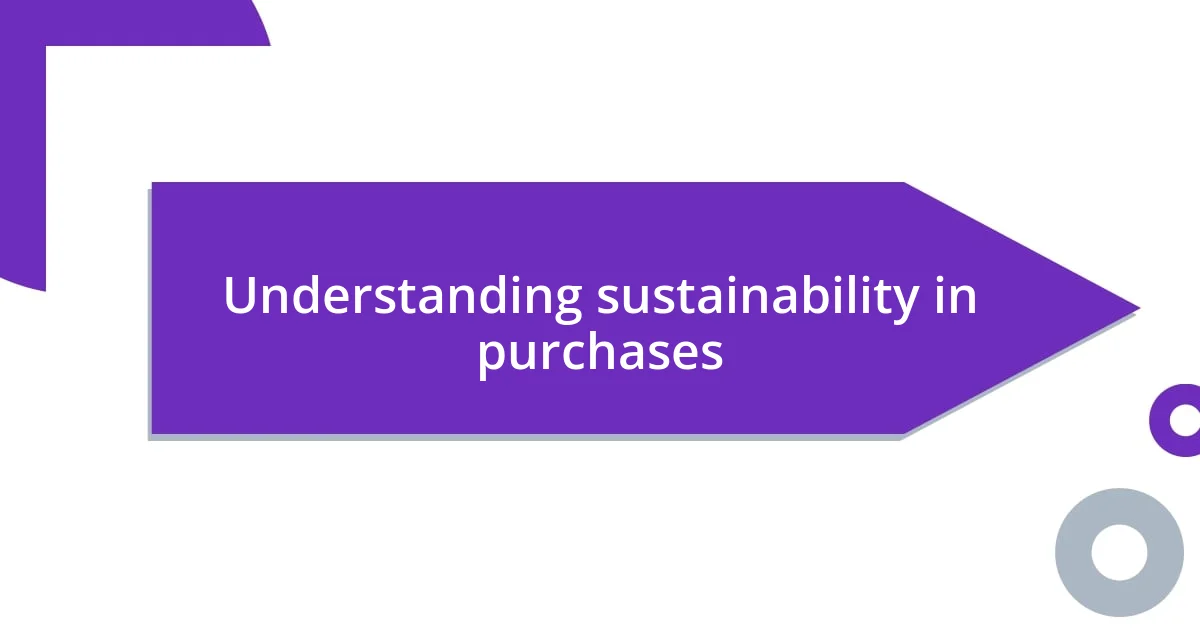Key takeaways:
- Understanding product lifecycles and the impact of purchases encourages conscious consumerism and shifts perspectives on sustainability.
- Evaluating material sourcing, ethical labor practices, and certifications fosters a sense of responsibility and supports ethical brands.
- Assessing the carbon footprint, product lifespan, and recyclability leads to informed decisions that align with personal values and promote environmental well-being.

Understanding sustainability in purchases
Understanding sustainability in purchases is something I’ve really come to appreciate over time. When I first started shopping with sustainability in mind, I found myself asking questions like: Is this product made from renewable resources? Is it designed to last? It’s fascinating how these queries can shift your perspective on everyday items.
One of the key moments that changed my approach was when I discovered the concept of a product’s lifecycle. I remember purchasing a pair of shoes only to later learn that their production process was harmful to the environment. That realization made me feel uneasy, prompting me to seek brands that prioritize ethical manufacturing processes and eco-friendly materials. It’s moments like these that can truly ignite a commitment to more sustainable choices.
I often think about the impact of our purchases and how they contribute to larger environmental issues. For instance, have you ever pondered how many plastic bags are used just for a single shopping trip? It’s staggering. By understanding sustainability, we empower ourselves to make conscious decisions that not only benefit our planet but also bring us a sense of fulfillment and responsibility as consumers.

Key factors in sustainable evaluation
When I evaluate the sustainability of my purchases, I focus on several key factors that really resonate with my values. I’ve come to realize that the origin of materials is crucial; knowing where a product comes from helps me support brands that value ethical sourcing. For example, I remember the moment I switched to buying organic cotton shirts. The thought of supporting sustainable farming practices just felt right. Here are some important factors to consider:
- Material Sourcing: Look for renewable or recycled materials that minimize environmental impact.
- Production Practices: Choose brands that prioritize ethical labor and eco-friendly manufacturing processes.
- Durability: Invest in products designed to last, reducing waste in the long run.
- Packaging: Consider environmentally friendly packaging options that prevent excess waste.
- Company Transparency: Support brands that are open about their sourcing and manufacturing practices.
Another aspect I think about is the product’s end-of-life. It’s surprising how many items I used to buy without considering where they would end up after use. I recall tossing a low-cost plastic kitchen gadget into the trash without a second thought—only to later learn how long it takes to decompose in a landfill. Now, I search for products that are easily recyclable or compostable, because it gives me peace of mind knowing that my choices align with my desire to reduce waste. So, it’s more than just a purchase; it’s a mindset shift toward responsible consumption.

Researching product sourcing and materials
When diving deeper into product sourcing and materials, one thing I’ve learned is that not all materials are created equal. For instance, a few months ago, I was looking for a new backpack for hiking. As I researched, I was surprised to find how many brands used synthetic materials that not only contributed to plastic waste but also weren’t biodegradable. I was genuinely torn between style and sustainability, but ultimately, I chose a backpack made from recycled materials. It felt rewarding, knowing my purchase helped keep plastic out of landfills while still getting the functionality I needed.
Knowing the sourcing of products gives me a sense of connection to what I buy. I often explore brands that share stories about their materials, such as how they source organic wool from farms that practice sustainable grazing. Recently, I came across a wool blanket that not only felt luxurious but was also sourced from local farmers who prioritize animal welfare. Understanding the journey of a product from pasture to consumer not only satisfies my curiosity but also makes me feel part of a larger community committed to sustainability.
I also pay close attention to certifications when examining product sourcing. Companies that obtain third-party certifications, like Fair Trade or Global Organic Textile Standard (GOTS), stand out to me. A while back, I remember feeling excited discovering a coffee brand with Fair Trade certification; it reassured me that my purchase supported ethical farming practices and provided fair wages to farmers. This knowledge transforms my shopping experience from mere consumption to a conscious act of support for people and practices I value.
| Material Type | Sourcing Considerations |
|---|---|
| Organic Cotton | Promotes sustainable farming; less pesticide use |
| Recycled Polyester | Diverts plastic waste; reduces need for virgin materials |
| Bamboo | Fast-growing; requires less water, though check for eco-certifications |
| Conventional Cotton | High water usage; typically involves harmful pesticides |

Assessing ethical labor practices
When I assess ethical labor practices, I often reflect on the stories behind the products I buy. For instance, a couple of years ago, I came across a small jewelry brand that showcased the artisans who crafted each piece. Seeing their faces and learning about their fair wages made the purchase feel like more than just a transaction; it felt like I was supporting their craft and livelihood. Doesn’t it feel good to know that your purchase contributes to someone’s well-being?
I also look for transparency in brands’ labor practices. Some companies go above and beyond, providing detailed accounts of their supply chains. The last time I researched a clothing brand, I was impressed by their commitment to fair labor conditions. They even had a section on their website dedicated to sharing factory audits and employee testimonials. It made me wonder, how often do we take the time to dig into the stories behind our favorite brands? It’s empowering to realize that our choices can drive change in the industry.
I’ve learned to appreciate certifications that reaffirm ethical practices, like Fair Trade or the Ethical Trading Initiative. Recently, I found a home goods brand that emphasized its commitment to both worker rights and environmental sustainability. The peace of mind that comes with knowing my purchase supports fair labor practices truly enhances my shopping experience. Have you ever had that moment of satisfaction when you realize your choices reflect your values? It’s a wonderful feeling, reminding me that conscious consumerism isn’t just a trend—it can make a tangible difference in the lives of workers around the globe.

Evaluating the carbon footprint
When evaluating carbon footprints, I often consider the entire lifecycle of a product. A while back, while searching for a new pair of shoes, I stumbled upon an eco-conscious brand that used a carbon offset program. They explained how my purchase contributed to projects aimed at reducing emissions globally. It was eye-opening to think that my consumer choice could play a role in combating climate change.
I also pay attention to the transportation methods used in getting products to market. I remember feeling conflicted about a popular electronics brand that ships their items internationally. The carbon emissions from air freight kept gnawing at me because it seemed counterproductive to support a brand that didn’t prioritize local sourcing. Have you ever felt that internal tug-of-war between convenience and sustainability? Choosing local options not only reduces transport emissions but also supports the community.
Lastly, I’ve come to realize the importance of energy efficiency in products, especially when it comes to appliances. I recently invested in an ENERGY STAR-rated refrigerator. Researching its energy consumption helped me see how much I could save not just on my electricity bill, but also in terms of reducing my overall carbon output. Every small decision feels impactful, don’t you think? It’s exciting to embrace choices that align with my values while fostering a healthier planet for future generations.

Considering product lifespan and recyclability
When considering product lifespan, I find myself drawn to items that promise durability. I remember investing in a high-quality backpack a few years back. Unlike cheaper alternatives that fell apart after a season, this one has held up remarkably well, proving that a slightly higher price tag often equates to better longevity. Isn’t it reassuring to think that making a smart choice today means less waste down the line?
Recyclability is another critical factor I constantly evaluate, especially with packaging. For instance, I recently tried a skincare brand that offered refillable containers. It felt fantastic to know that every time I restocked, I was minimizing waste rather than contributing to the pile of plastic found in landfills. Have you ever felt a sense of accomplishment when making a choice that aligns with sustainability? It really drives home the idea that my purchasing decisions can have a tangible impact.
I also take note of manufacturers’ recycling programs. A while ago, I discovered a technology company that encourages customers to return old devices for recycling. Knowing my obsolete gadgets could be repurposed instead of disposed of made me feel a lot better about my next electronic purchase. It raises an interesting question: how often do we think about what happens to our products when we’re done with them? Embracing brands with an emphasis on product lifecycle and responsible disposal truly reshapes my approach to shopping.

Making informed purchasing decisions
When it comes to making informed purchasing decisions, I find it crucial to research a brand’s values and practices before I commit to buying. Recently, I stumbled upon a clothing line that showcased their transparency in sourcing materials. Their commitment to ethical labor practices really resonated with me. It struck me how empowering it is to support brands that not only care about their products but also their people. Have you ever taken a moment to reflect on the stories behind what you buy?
I also pay attention to certifications and labels that denote sustainability. For example, I recall purchasing coffee that was certified Fair Trade and organic. Reading about how this certification ensured better incomes for farmers made the coffee’s richer taste even more satisfying. It brings to mind the question: does knowing how a product is made or sourced change how you feel about using it? For me, it certainly adds layers of meaning to my everyday choices, making each cup of coffee a small celebration of ethical consumerism.
Furthermore, I try to weigh the necessity of my purchases with a mindful approach. Once, I hesitated before buying a new smartphone because my existing one was still functional, even if slightly outdated. Reflecting on that moment led me to understand the power of simply holding off. Are we really benefiting ourselves or the planet by constantly upgrading? Choosing to cherish what I have not only helps me save money but also reinforces my commitment to a more sustainable lifestyle.














